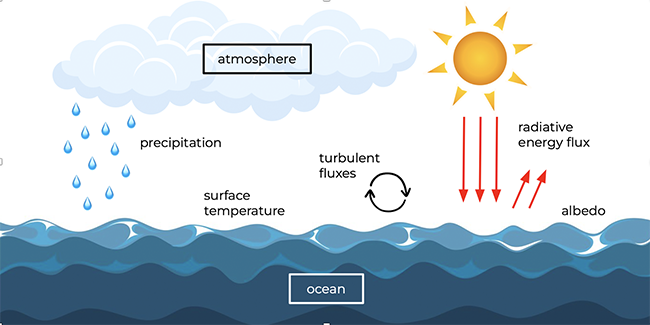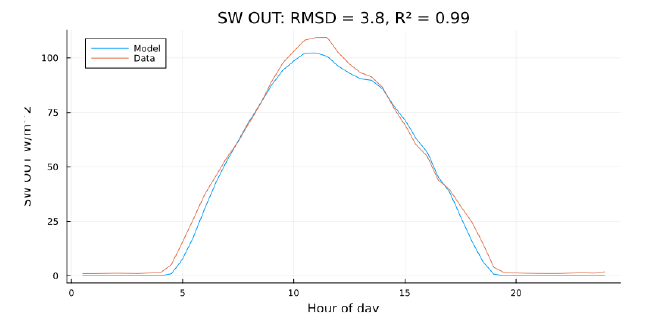
Projects
Climate Computing
Coupling Land Model
Coding at the Cutting Edge of Climate Science and Computing
PI: Tapio Schneider, Divisions of Geological and Planetary Sciences (GPS) and Engineering and Applied Sciences (EAS)
SASE: Julia Sloan, Scholar
Global mean temperatures continue to rise and will continue even with reduced CO2 emissions, but it is unclear how much. The uncertainties in global climate change projections have remained mostly unchanged since the 1960s, impeding society’s ability to assess environmental risks and take effective adaptation measures. The Climate Modeling Alliance (CliMA) is building the first Earth System Model (ESM) that automatically learns from diverse data sources to produce accurate climate predictions with quantified uncertainties. In addition, CliMA is utilizing recent advances in computing technology, including the use of GPUs, to make models faster and their resolutions finer, making it possible to better resolve important small-scale processes.
Atmospheric CO2 concentrations now exceed 400 parts per million, a level last seen over 3 million years ago, when Earth was 2–3°C warmer and the sea level was 10–20 meters higher than today. Even with reduced CO2 emissions, Earth will continue to warm and the sea level will continue to rise, but it is unclear by how much.
ClimaCoupler.jl
An Earth System Model is composed of multiple components, such as atmosphere, land, and ocean models. Each of these component models can be run on their own, which is useful for studying each of these domains independently and facilitates testing, calibration, and validation during model development. To gain understanding of the entire global system and predict future climate change, we need to run all of the component models together, including the feedback between them. This is where the coupling component, ClimaCoupler.jl, comes into play; the coupler enables communication between component models. Figure 1 shows some of the fluxes that the coupler exchanges between the atmosphere and ocean models.

Figure 1: Examples of some properties that the coupler exchanges between component models (between the atmosphere and ocean in this case). Some of these values, such as precipitation and surface temperature, are calculated within the component models, but others, such as turbulent fluxes, are calculated within the coupler itself because they depend on the states of both component models.
In this project, the Schmidt Scholar contributed heavily to the ClimaCoupler.jl codebase. Initially, this work involved refactoring the coupler codebase. The code was re-written to be much more readable to new and existing users alike, and for increased performance. Some of the functionality was found to be useful to software packages across the CliMA ecosystem and is in the process of being moved into a shared utilities package, ClimaUtilities.jl.
High performance of software is imperative for ESMs, as higher resolution models are necessary for accurate output but require more resources and time to run. CliMA aims to leverage modern computing advancements in multiple ways, including by running the entire model on GPUs. The Scholar was responsible for making the ClimaCoupler code GPU-compatible, and saw a 24x speedup in running the coupled atmosphere/land model on 4 GPUs as compared to 64 CPU processes.
ClimaLand.jl
This project also included work on CliMA’s land model, ClimaLand.jl. This model has an impressive modular design, allowing its individual pieces (e.g. soil and vegetation models) to be run in standalone or integrated modes. The Scholar has worked alongside research scientists to guide this design throughout model development, making sure that the implementation aligns with this overall structure.
Performance is a crucial goal in ESM development. In addition to enabling GPU compatibility of ClimaCoupler.jl, the Scholar reworked the ClimaLand.jl to get it running on GPUs as well. Another major performance improvement came from the use of implicit solvers in the land model. Using an implicit solver for differential equations instead of an explicit solver allows larger timesteps to be taken when evaluating the model. This results in less computation overall and faster model computation. The Scholar added functionality in ClimaLand to be able to use implicit solvers with the land model, and modified the soil water and heat equations (Figure 2) to be run implicitly rather than explicitly, resulting in a 100x timestep increase.

Figure 2: Outgoing shortwave radiation [W/m2] at the surface of the land throughout all hours of the day. This was produced by running the integrated soil + vegetation model for 30 days of simulation time, then averaging the radiation over all 30 days and compared to measured data.